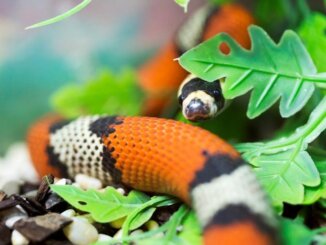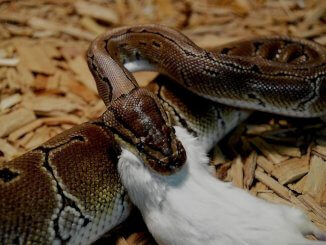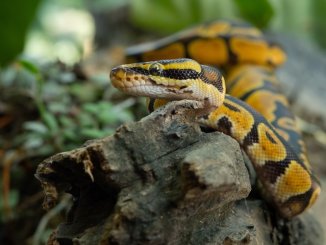Looking to choose the best snake for a beginner, but not sure where to start? Look no further than the Pied Ball Python!
These snakes make fantastic choices for first-time owners because they eat very infrequently, are extremely docile and tolerant, and are quite reluctant to bite. This makes them perfect for anyone who is inexperienced in handling reptiles too.
Ball Pythons get their name because they defensively curl up into a “ball” when they feel threatened.
Naturally found in Africa, Pied Ball Pythons are famous for their large white patches amongst their brown spotted or striped skin and will grow anywhere from three to five feet.
If this sounds like a snake you would like to adopt, then read on to learn how to care for them and where to purchase them from.
What Is A Pied Snake?
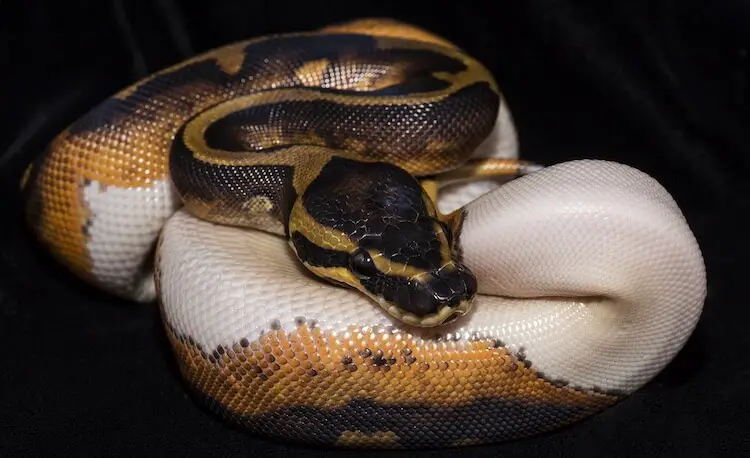
Scientifically known as Python regius, they inhabit the tropical and subtropical regions of Africa. Their native regions stretch from the western coast of Sierra Leone all the way west through Ghana and Liberia to Nigeria and to Uganda. Interestingly, they are not found south of the Equator.
Pied Ball Pythons are specifically known for their large white patches amongst their brown spotted or striped skin. This recessive trait of un-pigmented skin makes them very unique amongst Pythons.
They are also uniquely known amongst snake owners for their docile temperament and how easy they are to handle.
Their natural temperament make them very reluctant to bite, and because of this, they can be readily handled daily after being acclimated to their new home.
This snake, if they are taken care of properly, is generally very healthy in captivity and will live for between 20-30 years. Their typical feeding schedule is thawed rodents every fortnight and their tank care is not strenuous to maintain.
| Summary Table | |
|---|---|
| Common Names | Piebald Python, Pied and Piebald Royal |
| Scientific Name | Python regius |
| Adult Size | Three to five feet |
| Lifespan | 20-30 years |
| Diet | A thawed mouse or rat once every 2 weeks |
| Tank Size | Minimum 60 gallons |
| Humidity & Temperature | 80-85°F and humidity should be kept between 50-80% |
| Popular Alternatives | Smaller boa species |
Pied Ball Python Care Guide
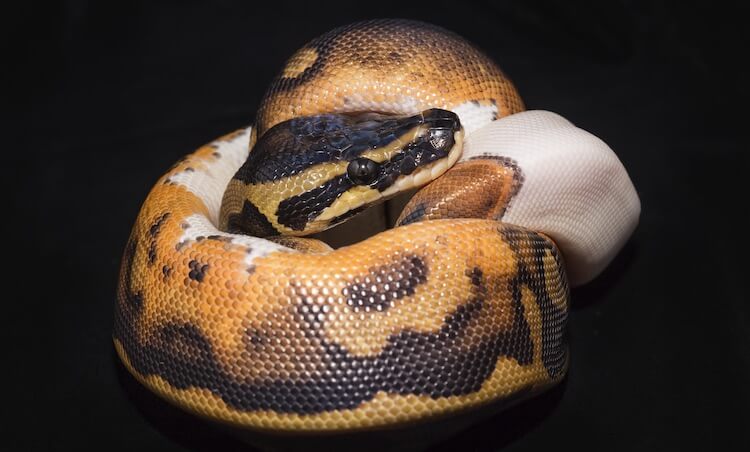
In the wild, the Pied Ball prefers to spend their time in grasslands, savannahs, and farmlands. They are nocturnal ground dwellers. This means they will spend their time during the day curled up in a “ball” in burrows sleeping. During the night they will hunt rodents or small lizards.
Tank and Enclosure
Pied Ball Pythons are able to live in a 60 gallon glass or plastic tank that is longer than it is tall.
Because they will nest in burrows during daylight hours, they should be provided with logs or other hiding places to stay in during the day.
Pythons in general are known for being good swimmers. The Pied Ball is no exception, and therefore, should be provided with a water dish large enough to soak in and not too small as to spill water every time they decide to soak.
Your python will use this dish for drinking and soaking.
Always remember they should have multiple entry and exit points from their water dish.
Heating and Lighting
During the day, whilst your snake burrows and sleeps the tank should be 80℉ and 85℉, with a basking spot that is 86℉-90℉. The night-time temperature of the tank should be maintained between 72℉-79℉.
A basking spot can be achieved through the use of a heat lamp. They do very well with a 75W Infrared Heat Lamp, your snake should not have direct contact with the heat source so that they do not burn themselves.
Full-spectrum lighting is recommended to mimic natural sunlight for your Python, however, unlike in specific lizards, it has not yet been proven that UVB lighting is beneficial for them.
This Snake should have about 12 hours of light and 12 hours of darkness. Lights should be turned off at night to allow the python to be active.
Tank humidity should be kept between 55%-60% which can be maintained by misting the tank daily or by placing the water dish near a heat source. Using a humidity gauge, which are readily available at many pet retailers, is a good way to track of tank humidity levels.
Substrate
Pied Ball Pythons are not too picky when it comes to substrate.
Soil, sand, and wood shavings are all substrates that can be easily found and will closely replicate their natural environment.
These substrates look more natural and can still be cleaned regularly, keeping the tank clean is a very important responsibility of any owner.
| Tank Tips | |
|---|---|
| Tank Type | 60 gallon plastic or glass tank |
| Lighting | Full-spectrum lighting |
| Heating | 75W infrared heat lamp |
| Best Substrate | Soil or wood shavings |
Feeding A Pied Ball Python
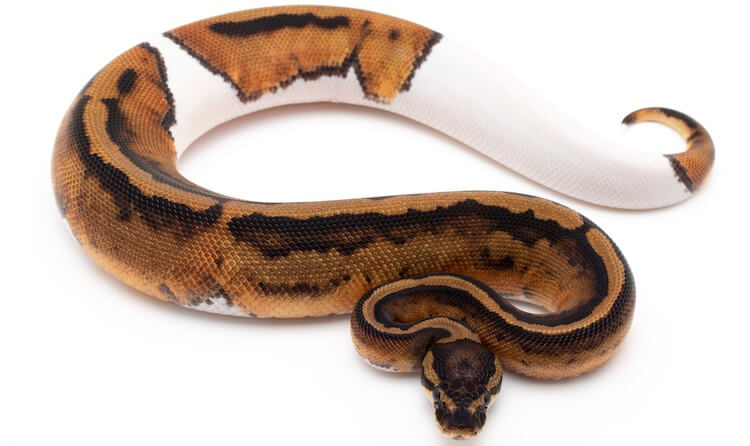
Pied Ball Pythons are carnivorous and feed infrequently in the wild eating only once a month.
In the wild they hunt at night and use thermal radiation to find their food. They have five labial pits on either side of their mouth that sense heat or infrared radiation. They use this unique attribute to find their food.
Despite it being easy to feed them infrequently in captivity, this snake can be picky with their food. Because they use thermal radiation to hunt, they will only eat live or freshly dead prey. More often than not, they will eat small rodents. If the rodent has been dead for too long, then your snake will be unable to find it.
Depending on the size of your Pied Ball Python, they should be fed an adult mouse or rat once every two to four weeks. Large snakes may eat more frequently (i.e. every two weeks), but their weight should be carefully monitored to determine how frequently they should eat.
Hatchlings will use energy stores from their egg sacs for the first 10 days of life. After this, they should be fed an appropriately sized rodent once per week.
Their prey should be roughly the same size as the middle girth of their body.
Rodents should be freshly dead or thawed. Live feed can be used but may be more difficult to handle than something that is dead. Thawed rodents may be more difficult for your snake to find and any uneaten food should be removed after two days.
Food for juveniles and adults may also be dusted with calcium or vitamin D supplement, but this is not necessary.
| Diet Summary | |
|---|---|
| Fruits | 0% of diet |
| Insects | 0% of diet |
| Meat | 100% of diet, small rodents |
| Supplements Required | Calcium and Vitamin D |
Common Health Issues
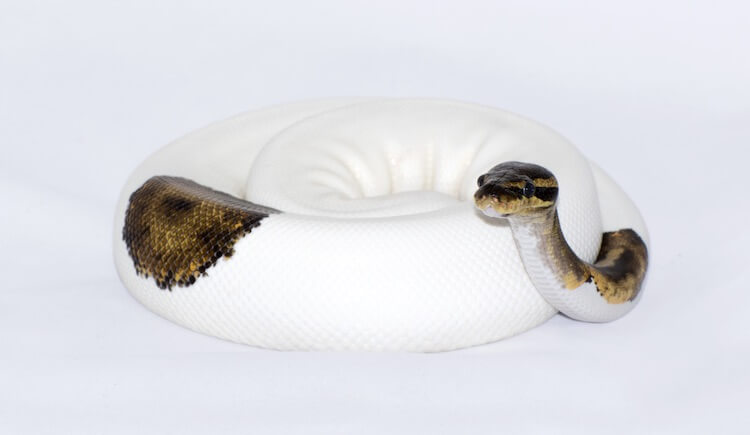
The Pied Ball Python is relatively healthy reptiles, and the most common health issues arise from bad husbandry. The following health issues are common problems that arise from bad husbandry:
- Anorexia
- Mouth Rot
- Respiratory Disease
- Tick Parasitism
Anorexia, or refusal to eat, can arise if the rodent provided is not fresh enough. If your snake loses weight, try varying the diet (e.g. thawed or live). If they still refuse, you may need to take your snake to the vet for further investigation.
Respiratory disease and mouth rot can both arise from bacterial growth in the cage, so cleaning regularly is essential (more on this below).
Tick parasitism should be handled as on any other animal, including people! Ticks should be properly removed, and your snake may need to be evaluated by a vet following this removal. Tick parasitism has a higher prevalence in males than females.
The Pied Ball Python’s lifespan is between 20-30 years in captivity. However, some have been reported to live to 40 years old.
Tank Cleaning
Because so many health issues arise from a bacteria-ridden enclosure, having good husbandry and a clean cage is a must-have for your snake!
Feces should be spot-cleaned whenever possible, and excess food should be removed out after two days of initial feeding. Waste should look large and brown, similar to the feces of skinks. Urate should always be white on the outside, and if broken open green or yellow on the inside.
About once a week or so, the enclosure should be fully cleaned out.
- Remove your python, substrate and any plastic (or real) plants or logs
- Thoroughly clean the cage with very diluted bleach
- Heavily rinse with water
- Whichever substrate you have chosen should be fully replaced
- Return your snake to their cage
This husbandry and cleaning process should be repeated if there is any evidence of bacterial growth.
| Signs They Are Healthy | Sickness Symptoms |
|---|---|
| Hiding during the day | Shedding in several pieces instead of one single piece |
| Good body condition and weight | Noticeably underweight with a prominent spine |
| Eating food provided at night | Bacterial growth or infection in the cage |
| Soaking and basking | Signs of ticks or other parasites |
Behavior and Temperament
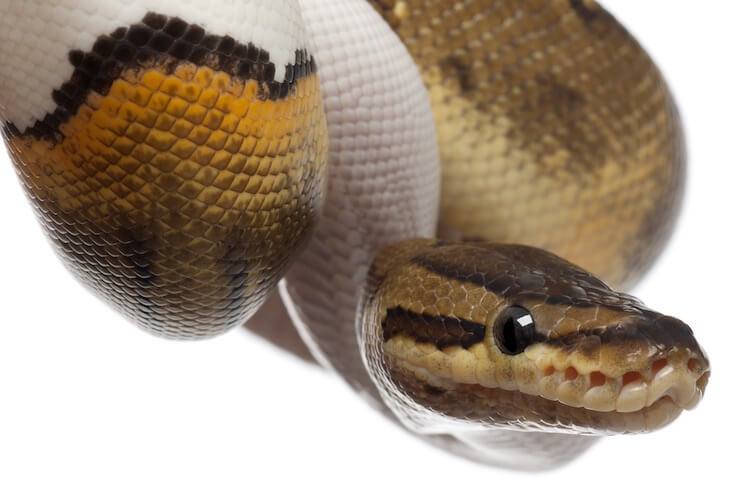
When faced with a fight or flight decision in the wild, the Pied Ball Python will choose flight.
They received their name “ball” because they curl up tightly into a ball when they are threatened. A rarer form of communication is hissing and striking, which this snake would rather choose not to do.
Pied Ball Pythons hunt by detecting thermal radiation (hence why they eat live rodents). They are nocturnal creatures so while in captivity, they will be inactive during the day and active at night. Inactivity may include basking or soaking in their water dish.
In terms of cohabitation, two Pythons should never be housed together unless you are breeding a male and female. A single male and female may live in the same burrow together in the wild, but this is the extent of their cohabitation.
Females brooding their eggs may refuse to eat during that time.
Handling Advice
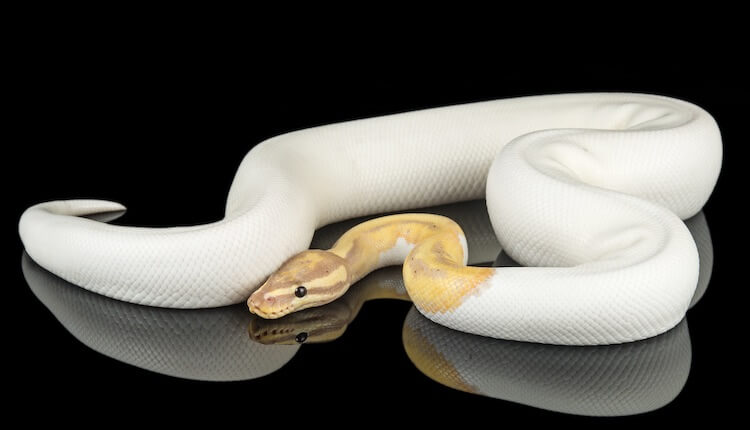
Snakes, among many reptiles like Geckos, carry the bacteria Salmonella. Because of this, it is important for you (and your python) that you wash your hands before and after handling.
It has been shown that handling a Pied Ball Python in 10 minute increments is non-stressful for the animal. Just always be aware of your snake’s comfort level.
Pied Ball Pythons can be handled weekly or even daily after adjusting to their new home. It may take them about a month to adjust to their new setting and become comfortable, during this time it is best not to handle.
You should handle with both hands, supporting both their front and back halves.
He will rarely bite, but, he is most likely to bite:
- If you are dangling prey directly in front of his face (so it is better to drop food directly into his cage instead of hand feeding)
- Before and during shedding, a capsule covers the snake’s eyes and they cannot see. Therefore, he is much more likely to strike or bite in defense.
All pythons, ball or not, are not venomous.
Pied Ball Python Appearance
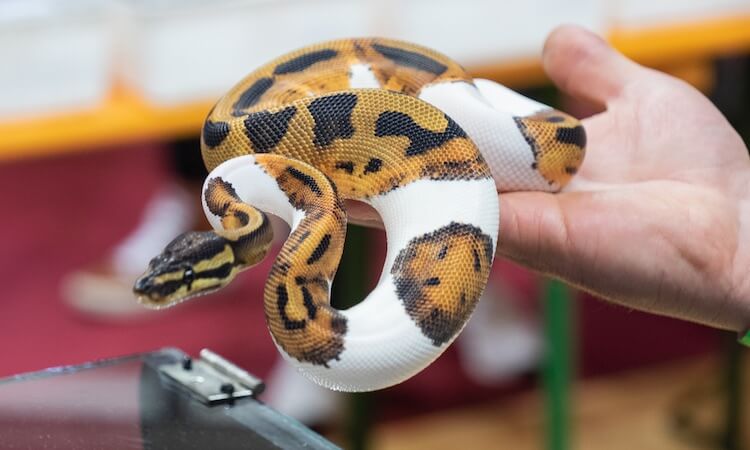
There are several patterns of Python, but the Pied Ball means that they have very large patches of plain white skin.
This pattern is very rare in wild populations however it is becoming increasingly common in captive. These white patches come with an otherwise medium to dark brown snake that has spots and stripes.
Easily identifiable by these large white patches, they also have slim necks and narrow heads. Gender differences are often undetected in hatchlings, but females have a higher postnatal growth rate and may start to look bigger than males as juveniles.
Adult females are generally larger and have a higher body condition than males do, and they also have a longer jaw relative to their body size.
How Big Do Pied Ball Pythons Get?
Newborns are 10-14 inches in length. Females will grow faster, but males reach sexual maturity sooner. They will reach sexual maturity at 12-18 months, while females will reach sexual maturity at 24-36 months.
Adults will measure between three to five feet in length with males being closer to three feet and females five feet (this is about average for most pet snakes).
They can weigh anywhere from 1,000 to 2,500 grams. However, large Pied Ball Python have been known to grow to 4,000 grams (nine pounds), and just with size, females tend to be heavier than males.
Coloring and Morphs
Pied, sometimes known as “piebald,” is a common color pattern in the animal world in horses, dogs, and sometimes reptiles, like in this case.
Pied Ball Pythons are brown or orange snakes with large white patches and stripes of unpigmented skin.
This snake will shed regularly and will likely soak themselves when they do. Make sure they have ready access to their soaking dish when they shed. They should shed all in one piece, and it is best to leave them alone during this period.
How Do You Get A Pied Ball Python?
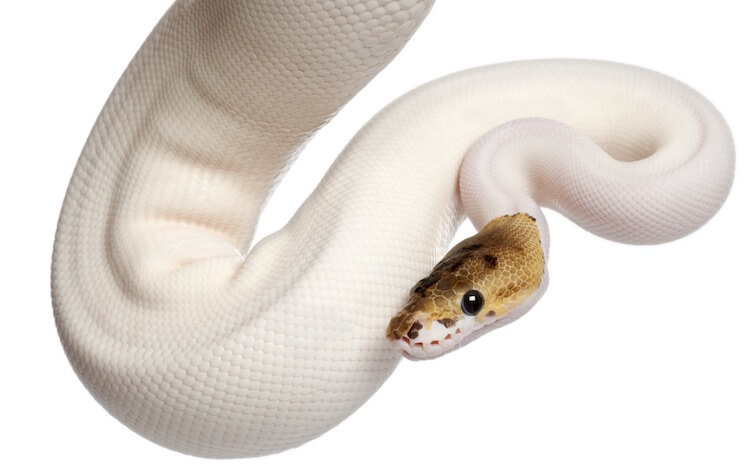
Ball Pythons, in general, can be bred in captivity, but are more often than not, are imported from the wild. However, because the Pied is less common in the wild, a Pied Ball Python will likely come from a breeder in captivity.
A good captive breeder will know exactly where their snakes have come from and the health of all of their snakes.
Being one of the most popular beginner snake pets, breeders are not very hard to come by.
How Much Are Pied Ball Pythons?
They will typically cost between $400 and $600 USD. However, rarer variations (e.g. Scaleless, Albino or Banana) can cost anywhere from $2,000 to $8,000 USD.
Breeding
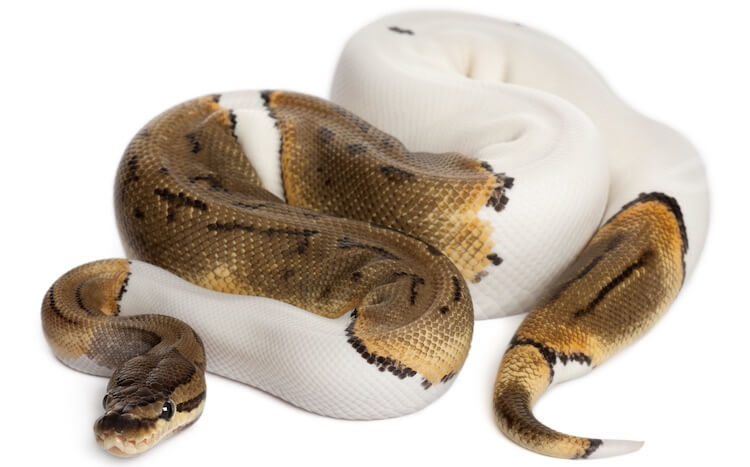
When male and female breed, they will lock together in copulation. When the female lays her eggs, they will incubate for two months.
During this time, females are known to brood their eggs. They will not eat during this time and will tightly wrap themselves around their clutches to maintain high incubation temperatures of 86-88℉.
Each clutch can have anywhere between three to 14 eggs, with the most common being five to nine.
Eggs in larger clutches may have a harder time surviving because it is harder for the mother to wrap herself around them.
In Africa, these clutches are born in tortoise or rodent burrows. In the wild, eggs tend to be laid in February, with the breeding season taking place from November to January.
Breeding in captivity is possible all year-round. Many breeders choose to breed their pythons from September to February, and eggs are laid from February to August. Some breeders will decrease the temperature of the enclosure by 10℉-12℉ for several weeks before introducing the snakes to each other.
When the babies are ready to hatch, they may take upwards of more than 24 hours to break out of their shells. At this point, they are about 10-14 inches in length. Once hatched, the mother no longer broods them.
During the first ten days of life, they will live off of the rest of their energy stores from their eggs. After this, they will take on a diet of eating a size-appropriate rodent once a week.
Care Guide Summary
| Why We Love Them | What Makes Them Difficult |
|---|---|
| Docile and reluctant to bite | Females brood eggs |
| Eat infrequently so are easy to care for | Can be picky if their food isn’t fresh enough |
| Great for first-time snake owners | Less common forms can be more expensive |
Pied Ball Pythons make great pet snakes for any experience level, especially beginners.
They are docile, don’t strike, are easy to handle and are relatively easy to care for.
Some boa constrictor snakes are also docile (and can make great pets), but they tend to be much larger and take up more space, so they may not be the best choice for someone who doesn’t have the capacity to house such a large reptile.
Unique in their coloring, they eat infrequently and are a manageable size for those that have minimal experience with handling snakes.
Their temperament makes them a great snake to have in captivity; because of this, they are common amongst breeders, and finding the right one for you should not be difficult.
If you do decide to adopt, make sure you are ready to have an exotic reptile for the next 20-30 years.
Let us know what you think about the Pied below.

